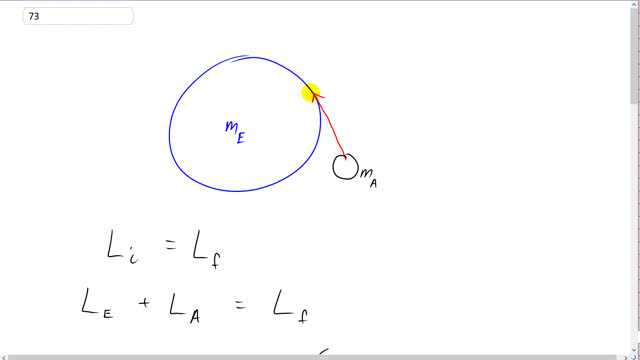
An asteroid of mass , traveling at a speed of 35 km/s relative to the Earth, hits the Earth at the equator tangentially, in the direction of Earth’s rotation, and is embedded there. Use angular momentum to estimate the percent change in the angular speed of the Earth as a result of the collision.

In order to watch this solution you need to have a subscription.
This is Giancoli Answers with Mr. Dychko. So we have the collision of two objects here: the asteroid colliding with the Earth and there's no external forces involved so that means momentum is conserved and we are dealing with angular momentum here. And this asteroid, it's going in a straight line but but once it collides with the Earth, it's gonna be traveling in a circle since it sticks to the Earth and at this very instant in time here when it's just at its point of contact, we can think of its linear momentum as being angular because if you consider any point on the edge of the Earth, it has angular momentum but any particular point is moving tangentally on the surface here and we can think of it as having angular momentum... does that make sense? Anyway so we have angular momentum of the Earth plus angular momentum of the asteroid separately before they are in contact with each other. That's the total initial angular momentum of the system that's just at the very instant when the asteroid is here but not quite touching yet and then afterwards, we have angular momentum of the Earth-asteroid system which would be a system with a moment of inertia due to the, you know, spherical Earth plus moment of inertia due to this point mass of the asteroid on the surface of the Earth and they'll be moving with some common angular velocity here, ω f. And initially just at the instant before contact, we have moment of inertia of the Earth times the Earth's angular velocity plus moment of inertia of the asteroid times the asteroid's angular velocity which we can write as its linear velocity divided by the radius of the Earth at that point. So we'll make a little approximation here to simplify our algebra a lot by saying that the moment of inertia of the asteroid is negligible and if we add it to moment of inertia of the Earth, we essentially just get the moment of inertia of the Earth anyway because this is so small in comparison to the Earth. And when we do that, we can take this term to the right hand side and factor out the I E and we get I E times ω f minus ω E equals moment of inertia of the asteroid times the asteroid's angular velocity. And then we can solve for ω f minus ω E and it's this I Aω A over I E dividing both sides by I E here and the reason that's useful is because when we find percent difference in the angular velocity before and after the asteroid collision, we want to take the difference in the angular velocities final minus initial and divide by the initial. And so here is an expression for the difference and then we divide that by ω E times it by 100 to get the percent change and so I Aω A over I E all over ω E works out to this and then substitute for the moment of inertia of the asteroid: mass of the asteroid times radius of the Earth squared times by angular velocity of the asteroid which is its linear velocity divided by the radius of the Earth and divide by the moment of inertia of the spherical Earth two-fifths mass of the Earth times its radius squared times its angular velocity. And r squared cancels top and bottom and this r goes on the bottom and the 5 goes on the top and maybe a better way of explaining that is to say you can multiply top and bottom by 5r so that the 5 here cancels leaving us with an r on the bottom and then the r's cancel on top leaving us with a 5 on the top. Okay. So we have 5m Av over 2m Erω E times a 100 and you plug that into calculator and where I have written 2π radians per day times 1 day for every 24 hours times 1 hour for every 3600 seconds for the angular velocity of the Earth ω E. And the velocity of the asteroid is 35 times 10 to the 3 meters per second times 1.0 times 10 to the 5 kilograms— mass of the asteroid—times 5 over 2 times—mass of the Earth— 5.98 times 10 to the 24 kilograms times—radius of the Earth—6.38 times 10 to the 6 meters and you get about 3 times 10 to the minus 16 is the percent difference of the asteroid; doesn't make much difference at all in percentage terms to the angular velocity of the Earth.